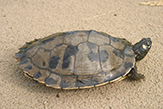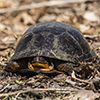Minnesota Reptiles
Reptilia (reptiles) is the class of animals that is characterized by breathing air, laying tough-shelled amniotic eggs, and having dry skin covered in scales and/or scutes (bony plates).
The Reptile Database, maintained at Zoological Museum Hamburg, lists all living reptile species, including turtles, snakes, lizards, and crocodiles, as well as tuataras and amphisbaenians, but it does not include dinosaurs. The most recent update, released in December 2022, lists 11,940 reptile species worldwide, 558 species in the United States, and 26 species in Minnesota.
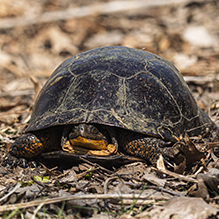
Recent Additions
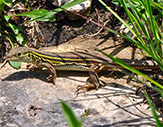
Six-lined racerunner (Aspidoscelis sexlineatus) is the largest lizard in Minnesota. It occurs on blufflands and river terraces in the southeastern part of the state. It is found mostly on south-facing bluffs, in river floodplains, and on sandy outwashes. Populations tend to be localized and isolated. Minnesota does not give it a protected status but lists it as a Species in Greatest Conservation Need.
Adults are most active in the morning, bask on rocks in the afternoon, and spend the night in a burrow (sound familiar?). They move with short, quick, bursts of speed. They will eat most arthropods, especially grasshoppers and crickets, but also beetle larvae, ants, spiders, and mollusks.
When attacked by a predator, the racerunner will detach its all or part of its tail. The tail will continue to wiggle and distract the predator while the racerunner seeks cover. The tail will regrow but will not be as long as the original.
Of the three lizards native to Minnesota, six-lined racerunner is the largest. There are three light yellow or yellowish-green stripes on each side. This is the feature that gives the racerunner its common name and distinguishes it from the other two lizards in Minnesota.
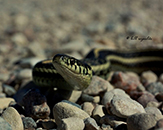
Plains garter snake (Thamnophis radix) is a medium-sized, nonvenomous snake. It is found through Minnesota except in the arrowhead region, but is most common in the western and metro counties. It is similar in appearance to, and difficult to distinguish from, the much more common and widespread eastern garter snake (Thamnophis sirtalis sirtalis).
The two species are distinguished by the position of pale lateral stripes and by markings on the upper jaw. Plains garter snake has pale lateral stripes on the third and fourth scale rows counting up from the belly scales. Each of the scales on the upper jaw (labial scales) has a bold black outline. Eastern garter snake has pale lateral stripes on the second and third scale rows, and none or at most one or two of the labial scales have a bold black border.
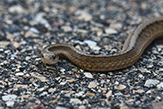
Dekay’s brown snake (Storeria dekayi) is a small nonvenomous snake, the second smallest snake found in Minnesota. It is relatively common but not often seen except by professional and amateur herpetologists. Although it is active during the day it is most often found by turning over a rock or a board lying on the ground. When threatened it will strike repeatedly, but its bite is neither venomous nor painful. Its mouth is not big enough to bite humans.
This species is identified by a row of black spots on each side of the pale dorsal stripe; and the cream-colored belly scales that are unmarked except for a very small black spot at each end.
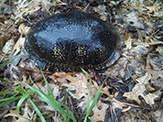
Blanding’s turtle is a long-lived, medium-sized turtle. Its conservation status in Minnesota is threatened and it is listed as a species in greatest conservation need. Threats include habitat degradation and road mortality. It occurs mostly in the eastern half of the state but also in scattered locations in western Minnesota. It is seldom seen because it is the first turtle to submerge when disturbed and the last to emerge after being disturbed.
This species is identified by the smooth, high domed shell and by the bright yellow chin and throat.
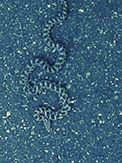
This is a medium to large, nonvenomous snake. It is one of the four largest snakes in Minnesota. Adults are usually 36″ to 56″ in length. In Minnesota it occurs mostly in the Mississippi, St. Croix, and Minnesota River valleys. It can be found from April to October in prairies, agricultural fields, woodland openings and edges, lowland meadows, river bottoms, and rocky outcroppings near water.
In the spring and fall adults move about during the day. In the hot summer they move about at night. When confronted they will often vibrate their tails producing a buzzing sound. In leaf litter or dry grass the sound resembles that of a rattlesnake. The reddish head resembles a copperhead. For these reasons the snake is often mistaken for a poisonous one and killed by humans.
Other Recent Additions
This list includes only reptiles that have been recorded in Minnesota, but not necessarily all of the reptiles found in Minnesota.
|
Lizards
|
|||||
|---|---|---|---|---|---|
| Profile | Photo | Video | |||
|
|||||
|
|||||
|
|||||
|
|||||
|
|||||
|
|||||
| Snakes
|
|||||
|---|---|---|---|---|---|
| Profile | Photo | Video | |||
eastern fox snake (Pantherophis vulpinus) |
|||||
massasauga (Sistrurus catenatus) |
|||||
|
|||||
|
|||||
|
|||||
|
|||||
|
|||||
|
|||||
|
|||||
|
|||||
|
|||||
|
|||||
|
|||||
|
|||||
|
|||||
|
|||||
|
|||||
|
|||||
|
|||||
|
|||||
|
|||||
|
|||||
|
|||||
|
|||||
|
|||||
| Turtles
|
|||||
|---|---|---|---|---|---|
| Profile | Photo | Video | |||
|
|||||
|
|||||
|
|||||
|
|||||
|
|||||
|
|||||
|
|||||
|
|||||
|
|||||
|
|||||
|
|||||
|
|||||
|
|||||
|
|||||
Coluber constrictor (North American racer)
Crotalus horridus (timber rattlesnake)
Diadophis punctatus (ring-necked snake)
Heterodon nasicus (plains hognose snake)
Heterodon platirhinos (eastern hognose snake)
Lampropeltis triangulum (milksnake)
Nerodia sipedon (common watersnake)
Opheodrys vernalis (smooth greensnake)
Pantherophis obsoletus (western ratsnake)
Pantherophis ramspotti (western fox snake)
Pantherophis vulpinus (eastern fox snake)
Pituophis catenifer (gopher snake)
Sistrurus catenatus (massasauga)
Storeria dekayi (Dekay’s brown snake)
Storeria occipitomaculata (red-bellied snake)
Thamnophis radix (plains garter snake)
Apalone mutica (smooth softshell)
Apalone spinifera (spiny softshell turtle)
Chelydra serpentina (common snapping turtle)
Chrysemys picta (painted turtle)
Emydoidea blandingii (Blanding’s turtle)
Glyptemys insculpta (wood turtle)
Graptemys geographica (northern map turtle)
No Species Page Yet?
If you do not see a linked page for a species in the list at left you can still upload a photo or video or report a sighting for that species. Click on one of the buttons below and type in the common name and/or scientific name of the species in your photo, video, or sighting. A new page will be created for that species featuring your contribution.
These buttons not working for you?
Simply email us at info@MinnesotaSeasons.com.
